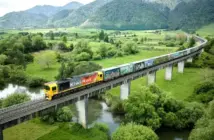New Zealand’s third-largest log exporter after Tauranga and Whangarei is doing everything possible over the next five years to ensure it’s ready for Gisborne’s booming forestry industry, says Eastland Port General Manager Andrew Gaddum.
A total of 155,709 hectares of the East Coast are planted in plantation forest, comprising nine per cent of the country’s plantation forests in 2015, he notes.
“We’ve recently announced our Twin Berth Development plan for Eastland Port so that it can cope with the huge amount of wood coming from our local forests, and be ready for coastal shipping and new international trade and exports.
“When regions invest in great infrastructure communities have greater access to economic opportunities and growers have efficient ways to move goods to market.
to move goods to market.
“As a result productivity soars, opportunities increase, and our society thrives,” he says.
Eastland Port moved a record volume of 2.5 million tonnes of product in the year ending March 2017 – a 400 per cent increase on 2006/2007 figures.
Currently 11,600 tonnes of wood is loaded each day.
These increases reflect the unyielding international demand and high prices being paid for timber, Gaddum explains.
“All of this is great news for the region.
“But the problem we have at Eastland Port is that we can handle 2.9 million tonnes of wood a year – but not much more.
“At present the port (and the entire East Coast forestry industry) relies on a single log ship berth.
“With more wood coming it’s simply not viable to park up and load only one log ship at a time.
“So, after looking at options we’ve come up with what we think is the best solution: parking two 200m long ships in port and loading them at the same time.
“Creating the twin berths will cost around $70 million over five years.”
Eastland Port is part of regional infrastructure company Eastland Group, which is 100 per cent owned by Eastland Community Trust (ECT).
Funding will come from operational cashflow and borrowings.
A large part of the spend will be on repair and maintenance of structures at the end of their design life.
Once the work is completed the port becomes a fantastic long term investment and a modern asset, Gaddum maintains.
“The nature of a port is that it must change and respond to the needs of regional industry, however we don’t expect we’ll need to heavily invest in infrastructure again for some time.
“The port’s current profitability (thanks to forestry) gives us confidence this is a sound business investment.
“Most logs arriving now are from the first rotation.
“Land owners are replanting trees as quickly as they cut them down, ensuring the industry’s sustainability.”
But port development is about more than just wood, Gaddum stresses.
“New awakening to New Zealand’s earthquake and weather vulnerability has promoted a major rethink about coastal shipping.
“Future-proofing the port for new international trade and exports is also important.
“New Zealand’s trade relationship with China has nearly tripled over the past decade and there’s no reason why in the future Gisborne could not support a viable and regular coastal shipping service taking containers to Tauranga, Napier or Auckland.
“Several forces are coming together to produce a moment in time when investment in infrastructure has become both an imperative need and an opportunity to create the productivity stimulus the region needs for the next century.
“If we can enhance our thriving port we can make it happen for our community in the future.
“We can’t put off developing our infrastructure any longer,” Gaddum insists.
Check out www.twinberth.nz for more information.




